#ornithischians
Text
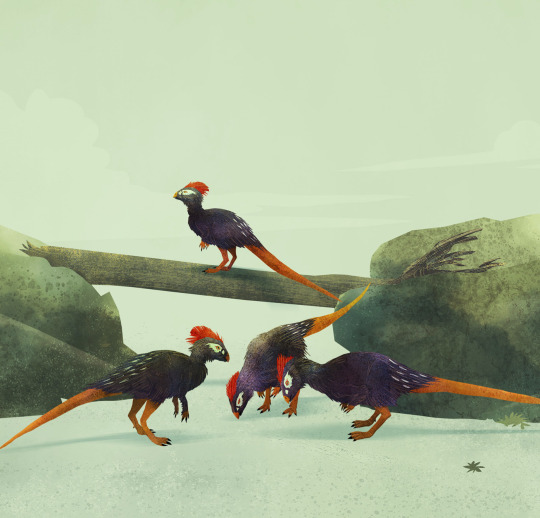
Some hungry Abrictosaurus consors checking out a dried out river bed in Early Jurassic South Africa
#dinosaur#paleoart#illustration#paleontology#paleoillustration#paleoblr#palaeoblr#art#palaeontology#jurassic period#jurassic world#ornithischians#heterodontosaurid#south africa#lesotho#dinosauria
2K notes
·
View notes
Text

Portrait of the famous duck-billed dinosaur Corythosaurus casuarius
#paleoart#dinosaur#dinosaurs#paleontology#corythosaurus#hadrosaur#ornithischian#orinthopoda#ornithopod#ornithopods#ornithischians#hadrosaurs#lambeosauridae
196 notes
·
View notes
Text

Thyreosaurus
#art#my art#digital art#paleoart#paleontology#palaeoblr#archosaurs#dinosaurs#ornithischians#thyreophorans#stegosaurs#thyreosaurus#this took a while gh
77 notes
·
View notes
Text
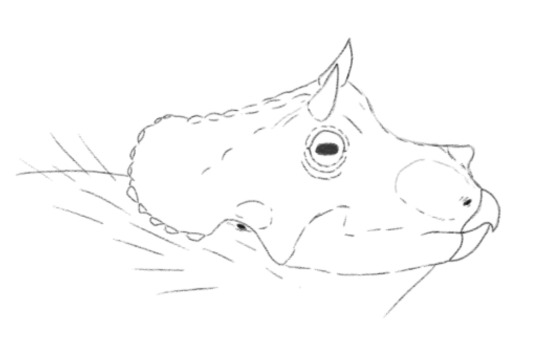
A baby Triceratops based on specimen UCMP 154452, there's definitely a few things wrong with it, especially considering I used a grainy photo of the skull for reference, but it was still fun to draw
62 notes
·
View notes
Text

Paleovember 2023, Maiasaura!
Living in Canada and Montana around 76 mya, Maiasaura is particularly famous for being the species that proved that dinosaurs (or at least hadrosaurs) looked after their young, hence the name 'mother lizard'. This is thanks to particularly rich bonebeds preserving nesting grounds with specimens of just about every age, giving us a strong look at the nesting habits and life cycle of the average Maiasaura.
#maiasaura#dinosaur#hadrosaur#ornithischians#paleoart#paleontology#prehistoric#illustration#art#artwork#cartoon#digitalart#drawing#procreate#late cretaceous#artist on tumblr
90 notes
·
View notes
Text
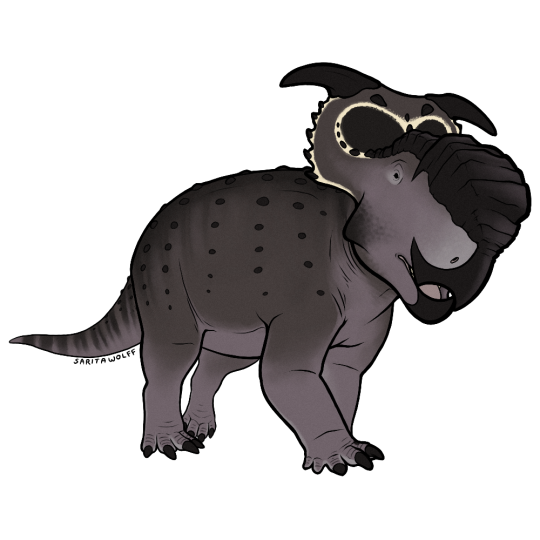
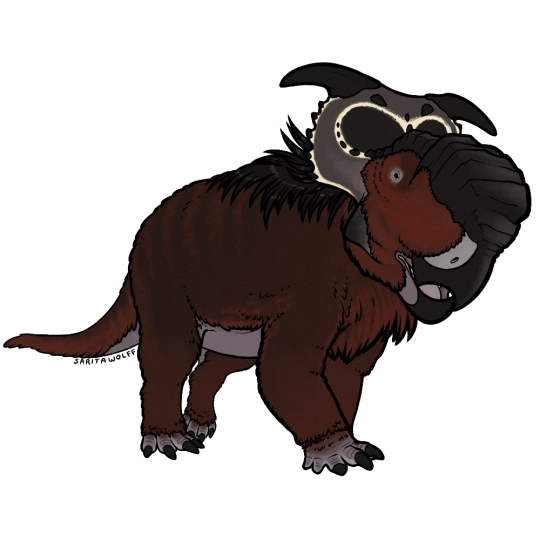
A Patreon request for rome.and.stuff (Instagram) - Pachyrhinosaurus perotorum… that I went a bit overboard with lol. I’ve been waiting for an excuse to draw my favorite ceratopsian, and to digitally adapt my old Pachy marker drawing design.
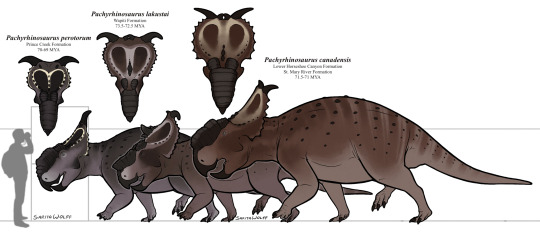
So! Pachyrhinosaurus! As seen above, there were three known species of Pachyrhinosaurus, living in different locations and eras in Late Cretaceous North America.
The oldest, P. lakustai, was native to the Wapiti Formation of Alberta and British Columbia, Canada. It’s known for the extra spikes it has at the center of its frill.
The slightly younger P. canadensis was native to the lower Horseshoe Canyon Formation and the St. Mary River Formation of Alberta and northwestern Montana. It was the largest of the three.
The youngest, P. perotorum, was native to the Prince Creek Formation of Alaska. As this ceratopsid seemingly stayed put during the long, dark, cold Alaskan Winters, it likely had adaptations for keeping warm.

The depiction of a “woolly” Pachyrhinosaurus was first popularized by Mark Witton as a speculative work, but the trope has prevailed. While many paleontologists find a heavy feather covering on a centrosaurine to be highly unlikely, and maintain that the animal’s size and homeothermy would have kept it warm enough, we still have no skin impressions to suggest that P. perotorum was fully scaly. So a feather coating is not completely out of the question (though it is unlikely). Still, I love the look of a woolly Pachyrhinosaurus and how it challenges our previous conceptions of non-avian dinosaurs. Stranger things exist in nature. I had to include a “woolly” option, especially since I already use the guy as my avatar on my paleo Instagram account, SaritaPaleo.
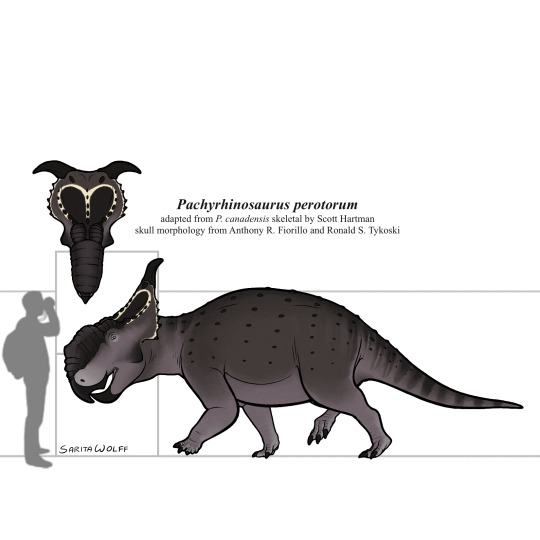
Pachyrhinosaurus was particularly unique in that it seemingly traded off something that had previously worked for other ceratopsians, horns, for a large nasal boss instead. For Pachyrhinosaurus, a battering ram worked better than a sword.
It was herbivorous, using its strong cheek teeth to chew tough, fibrous plants. Perhaps during the dark and cold Winters, P. perotorum would have also dug for roots or even scavenged carcasses. At any rate, from observations of their unusually conspicuous growth banding, it appears growth for P. perotorum would have been stunted during the harsh Winter, but was extremely rapid in the warmer months, an adaptation for the Alaskan climate.
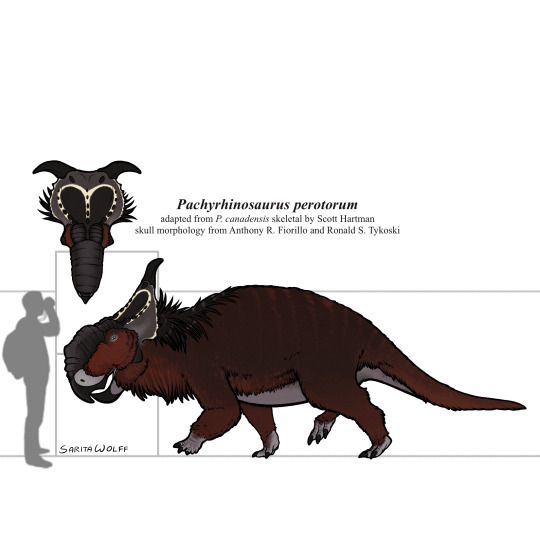
The tundra of the Prince Creek Formation housed a surprising amount of diversity. Pachyrhinosaurus perotorum would have lived alongside smaller ceratopsians like Leptoceratopsids, as well as other ornithischians like the pachycephalosaurine Alaskacephale and the hadrosaurid Edmontosaurus. Theropods such as Dromaeosaurus and Saurornitholestes, as well as a yet unidentified giant Troodontid, lived here as well. P. perotorum’s main predator would have been the tyrannosaur Nanuqsaurus. Small mammals were also somewhat common here, such as Cimolodon, Gypsonictops, Sikuomys, Unnuakomys, and an indeterminate marsupial.
(Btw, the request tier for Patreon starts at only $5 a month. 😉 Link is pinned at the top of my blog.)
#my art#SaritaDrawsPalaeo#Pachyrhinosaurus#Pachyrhinosaurus perotorum#Pachyrhinosaurus lakustai#Pachyrhinosaurus canadensis#Centrosaurines#ceratopsians#ceratopsids#ornithischians#dinosaurs#archosaurs#archosauromorphs#reptiles#Prince Creek Formation#Wapiti Formation#Horseshoe Canyon Formation#St. Mary River Formation#Late Cretaceous#Canada#United States of America
78 notes
·
View notes
Text
Pachycephalosaurus.
Cretaceous. 100-66MYA.
These ornithischians are kinda nebulously placed within the phylogenetic tree? It may be possible though that they evolved from Ceratopsians like Psitaccosaurus and Yinlong but this is a tentative placement for the moment.
#video#art#paleontology#my art#paleoart#science#dinosaur#dinosaurs#ornithischians#pachycephalosaurus
34 notes
·
View notes
Text


My take on Thyreosaurus
20 notes
·
View notes
Text
Parasaurolophus (Beside Crested Lizard) was a Hadrosaurid Ornithopod Dinosaur from western North America during the late Cretaceous period (76.9-70.5 Mya).
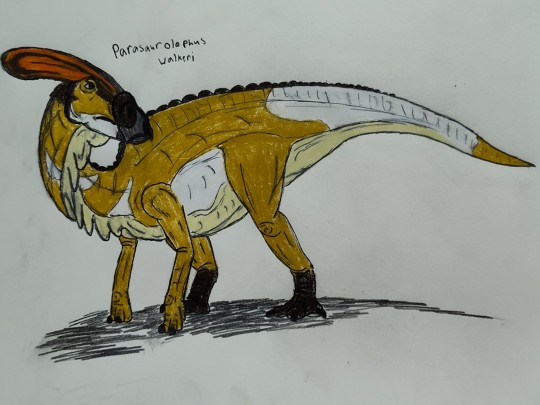
This iconic Hadrosaur is known for its long crest on top of its head, which it likely used for display and for vocalization. Parasaurolophus is the only dinosaur we currently know what it might have sounded like. Thanks to well preserved fossils and computer modeling, scientists have been able (through methods beyond my expertise) to reconstruct the sounds Parasaurolophus could have made. Unfortunately we may never understand the possibly complex social uses for these vocalizations, but maybe science will surprise us one day as it has many times before.
#parasaurolophus#paleoart#paleontology#evolution#dinosaur#dinosaurs#birds#ornithopods#ornithischians#hadrosaurs#Cretaceous
16 notes
·
View notes
Text
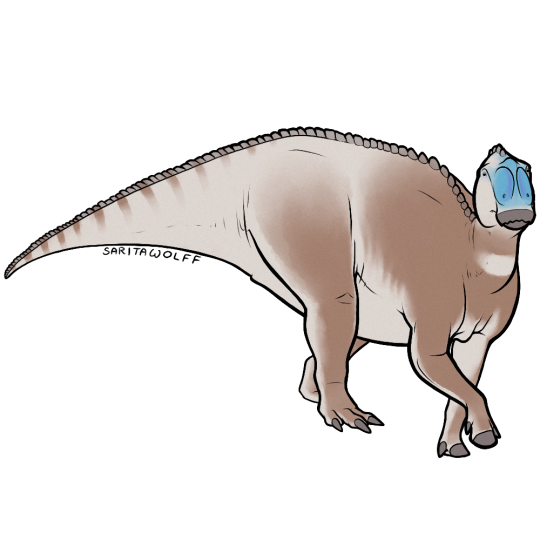
Patreon request for @/rome.and.stuff (Instagram) - Secernosaurus koerneri
Secernosaurus was a member of a small group of hadrosaurs native to South America: the Austrokritosaurs, and it was the first of this group to be formally named. Most hadrosaurs lived in Laurasia (what is now North America and Eurasia) which was seperated from South America in the Cretaceous. The existence of Secernosaurus and its relatives suggests a land bridge temporarily formed between North and South America at this time, allowing North American kritosaurines to migrate South.
So far, only one specimen of Secernosaurus has been found. This fossil was previously thought to belong to a subadult, but recent study shows it was likely mature, or at least almost mature. This makes it the smallest of the Austrokritosaurs, only 4–5 metres (13–16 ft) long. Still a large animal, but rather small by hadrosaur standards!
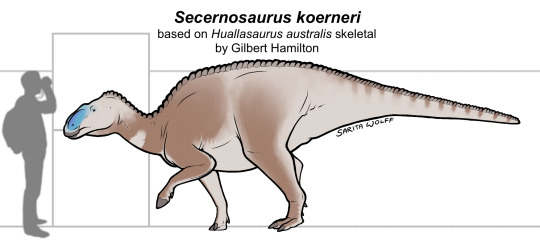
Secernosaurus received its big screen debut in Prehistoric Planet’s second episode, however, the design of the animals were based off the better known Huallasaurus australis, as Huallasaurus was thought to be a species of Secernosaurus at the time.
Secernosaurus koerneri lived in the Late Cretaceous Lago Colhué Huapí Formation In Argentina. As depicted in Prehistoric Planet, this environment was semi-arid with large deposits of gypsum, and fluctuated between seasonally wet conditions and intense aridization. But Secernosaurus wasn’t the only dinosaur in this environment. It shared the formation with titanosaurs like Elaltitan lilloi, Argyrosaurus superbus, and Aeolosaurus rionegrinus. Fragmentary remains of dromaeosaurids and megaraptorids have been found here, as well as the ornithischians Notoceratops (which could have been either a ceratopsian or another hadrosaur) and Sektensaurus (a possible elasmarian). Turtles, pseudosuchians, and lungfish have also been found, which would have made use of the floodplains during the wet season and possibly aestivated during the dry.
#Secernosaurus koerneri#Secernosaurus#kritosaurine#saurolophine#hadrosaurs#hadrosaurids#ornithopods#ornithischians#dinosaurs#archosaurs#archosauromorphs#reptiles#Lago Colhué Huapí Formation#Late Cretaceous#Argentina
13 notes
·
View notes
Text
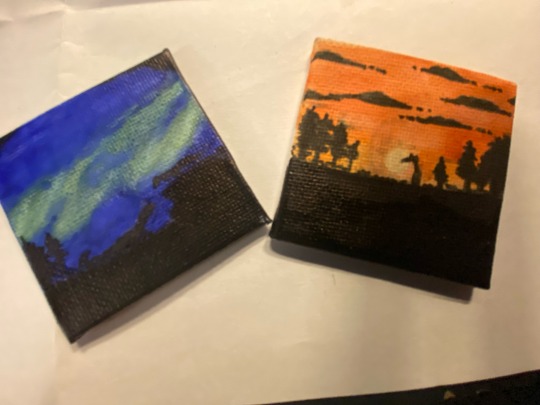
Rare irl pieces

Tiny azhdarchid sunset

And nanuqsaurus looks at a herbivore, potentially an Alaskacephale w a shaggy tail or any of the indeterminate ornithischians from the prince creek

Low quality Azhdarchid closeup

Low quality Aurora borealis closeup
#art#irl art#taditional art#canvas#tiny canvas#microscopic canvas#azhadarchid#pterosaur#sunset#conifer tree#pine trees#conifers#cloud#pretty#aurora borealis#tyranosaur#nanuqsaurus#alaskacephale#pachycephalosaur#ornithischians#marginocephalian#dinosaurs#dinosaur
7 notes
·
View notes
Text
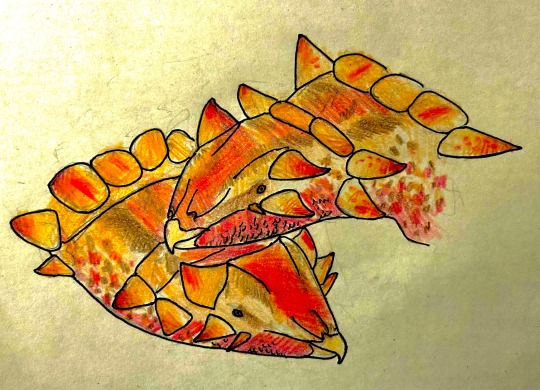
Impresssion of the newly-discovered ankylosaurian dinosaur Datai yingliangis, which lived about 96-90 million years ago in the Late Cretaceous of what is now the Zhoutian Formation of China’s Jiangxi Priovince.
#paleoart#dinosaur#dinosaurs#paleontology#datai#ankylosauria#ornithischians#ornithischian#ornithischia#datai yingliangis
70 notes
·
View notes
Text

gghhh,
#art#my art#digital art#paleoart#paleontology#palaeoblr#archosaurs#dinosaurs#ornithischians#thyreophorans#ankylosaurs#datai#datai yingliangis#queue
58 notes
·
View notes
Note
I know it's weird to imagine the Triceratops being called a bird, even though they're still related. But to me as a kid I felt their beak-like mouths resembled something more of a bird mouth/beak or mainly a parrot's that made me wonder if it was an evolutionary trait passed down to birds. Of course that was before learning how some things/traits are just repeated in nature.
Like, the two beaks aren't the same - they evolved independently - but honestly ornithischians are just so birdie on their own I accept them as birds
28 notes
·
View notes
Text

More woolly pachys :)
#pachyrhinosaurus#dinosaur#paleoart#prehistoric#prince creek formation#ceratopsian#ornithischians#fluffy pachyrhinosaurus
5 notes
·
View notes
Text
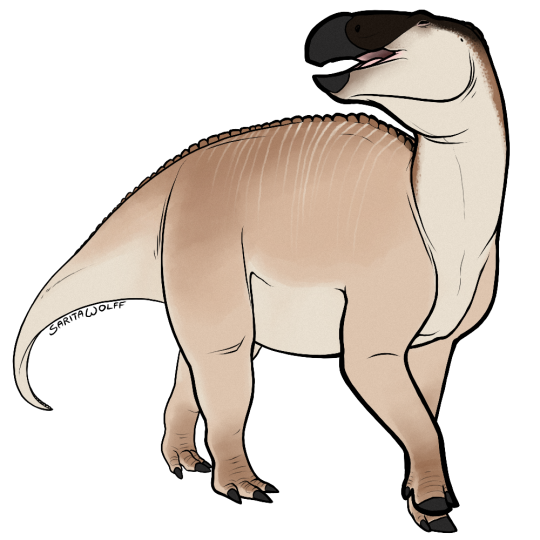
#Archovember Day 16 - Shantungosaurus giganteus
While hadrosaurs tend to be perceived as horse or cow-size, there were some intimidatingly huge members of the family. As the largest hadrosaur discovered so far, Shantungosaurus giganteus could reach 15 metres (49 ft) to 16.6 metres (54 ft) long and weigh an estimated 13 metric tons (14 short tons) to 16 metric tons (18 short tons). It lived in Late Cretaceous China, and would have filled a niche typically filled by sauropods in its ecosystem. As these dinosaurs have been found in a mass grave, it’s likely they also traveled in large, formidable herds. Shantungosaurus also had very large nostril holes which were probably covered by flaps of skin that could have inflated to amplify its calls.

Shantungosaurus lived alongside other hadrosaurs like Laiyangosaurus, Tanius, and Tsintaosaurus, all quite large animals but still overshadowed by Shantungosaurus. It would have also lived alongside a diverse array of ceratopsians like Sinoceratops, Ischioceratops, Zhuchengceratops, and Micropachycephalosaurus, as well as the ankylosaur Pinacosaurus and the oviraptorosaur Anomalipes. So far, only one sauropod has been found in this area, Zhuchengtitan, the tallest animal in its ecosystem… beating Shantungosaurus by a neck. The apex predator of this region was the tyrannosaur Zhuchengtyrannus. However, it’s likely would not have been able to take on an adult Shantungosaurus, but could have picked off young or sick individuals that strayed from the herd.
#my art#SaritaDrawsPalaeo#Shantungosaurus giganteus#Shantungosaurus#edmontosaur#hadrosaurs#hadrosaurids#ornithopods#ornithischians#dinosaurs#archosaurs#archosauromorphs#reptiles#Archovember#Archovember2023
34 notes
·
View notes